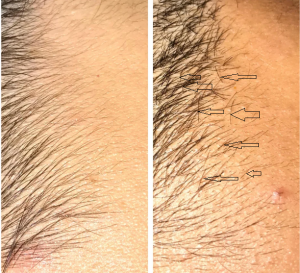The presence of side effects during pharmacological treatment is unfortunately a quite common problem. In this review, we focused our attention on adverse events related to 5 alpha-reductase (5?-R) inhibitors (i.e., finasteride and dutasteride), approved for the treatment of benign prostatic hyperplasia and androgenetic alopecia (AGA).
Although these drugs are generally well tolerated, many reports described adverse effects in men during treatment, such as sexual dysfunction and mood alteration. In addition, it has been also reported that persistent side effects may occur in some AGA patients. This condition, termed post-finasteride syndrome (PFS) is characterized by sexual side effects (i.e., low libido, erectile dysfunction, decreased arousal and difficulty in achieving orgasm), depression, anxiety and cognitive complaints that are still present despite drug withdrawal. Indeed, some national agencies (e.g., Swedish Medical Products Agency, the Medicines and Healthcare Products Regulatory Agency of UK and the U.S. Food and Drug Administration) required to include multiple persistent side effects within the finasteride labels.
As here reported, these observations are mainly based on self-reporting of the symptomatology by the patients and few clinical studies have been performed so far. In addition, molecular mechanisms and/or genetic determinants behind such adverse effects have been poorly explored both in patients and animal models. Therefore, results here discussed indicate that PFS is an emerging clinical problem that needs to be further elucidated.
This article in full can be found here: https://www.sciencedirect.com/science/article/pii/S235228951930061X?via%3Dihub#bib122https://www.sciencedirect.com/science/article/pii/S235228951930061X?via%3Dihub#bib122
http://tau.amegroups.com/article/view/39898/html
Original Article
Penile vascular abnormalities in young men with persistent side effects after finasteride use for the treatment of androgenic alopecia
Mohit Khera1, Jeffrey K. Than2, James Anaissie1, Ali Antar1, Weitao Song1, Boriss Losso1, Alexander Pastuszak3, Taylor Kohn4, Jorge Rivera Mirabal1
1Scott Department of Urology, Baylor College of Medicine, Houston, TX, USA; 2Baylor College of Medicine, Houston, TX, USA; 3Division of Urology, Department of Surgery, University of Utah School of Medicine, Salt Lake City, UT, USA; 4The James Buchanan Brady Urological Institute at Johns Hopkins School of Medicine, Baltimore, MD, USA
Contributions: (I) Conception and design: All Authors; (II) Administrative support: All authors; (III) Provision of study materials or patients: M Khera; (I) Collection and assembly of data: All authors; (I) Data analysis and interpretation: All authors; (I) Manuscript writing: All authors; (I) Final approval of manuscript: All authors.
Correspondence to: Mohit Khera, MD. Professor, Scott Department of Urology, Baylor College of Medicine, 7200 Cambridge St, Suite 10B, Houston, Texas 77030, USA. Email: mkhera@bcm.edu.
Background: The constellation of persistent sexual, neurological, and physical adverse effects in patients who discontinue 5?-reductase inhibitors (5ARIs) has garnered recent concern. The objective of this study was to evaluate potential penile vascular changes and persistent adverse effects of 5ARIs in men treated for androgenic alopecia (AGA).
Methods: This was a prospective case-control study with 25 subjects with a history of 5ARI use for AGA and 28 controls. Patient self-reported questionnaires including the International Index of Erectile Function (IIEF), International Prostate Symptom Score (IPSS), Patient Health Questionnaire-9 (PHQ-9), the Epworth Sleepiness Scale (ESS) and the Androgen Deficiency in the Aging Male (ADAM) were used. Penile duplex Doppler ultrasound (PDDU) results were evaluated in men with a history of 5ARI use.
Results: A significant difference in total IIEF score between the 5ARI (median: 35; IQR: 29–43) and control group (median: 29; IQR: 27–32) (P=0.035) was observed. Seventeen 5ARI subjects (68%) had a vascular abnormality on PDDU. The median (IQR) for total IPSS score for the 5ARI group was 10 [5–16] compared to 3 [2–8] for the controls (P<0.01). The 5ARI group had a higher median total PHQ-9 score than controls [10 (6.5–16) vs. 1 (0–2) (P<0.001)]. Two subjects (8%) committed suicide during or after the study.
Conclusions: While the sexual side effects of 5ARIs are well known, there may be persistent genitourinary, physical, psycho-cognitive, anti-androgenic and penile vascular changes after 5ARI discontinuation. Use of 5ARIs for treatment of AGA may lead to persistent sexual, genitourinary, physical, psycho-cognitive, and anti-androgenic sequelae even after cessation of 5ARI therapy.
Keywords: Finasteride; penile duplex Doppler; major depressive disorder; hypogonadism; erectile dysfunction (ED)
https://wjmh.org/search.php?where=aview&id=10.5534/wjmh.200012&code=2074WJMH&vmode=FULL
| Health Risks Associated with Long-Term Finasteride and Dutasteride Use: It’s Time to Sound the Alarm |
Abdulmaged M. Traish  |
| Department of Urology, Boston University School of Medicine, Boston, MA, USA.
|
|
Abstract
|
| 5?-dihydrotestosterone (5?-DHT) is the most potent natural androgen. 5?-DHT elicits a multitude of physiological actions, in a host of tissues, including prostate, seminal vesicles, hair follicles, skin, kidney, and lacrimal and meibomian glands. However, the physiological role of 5?-DHT in human physiology, remains questionable and, at best, poorly appreciated. Recent emerging literature supports a role for 5?-DHT in the physiological function of liver, pancreatic ?-cell function and survival, ocular function and prevention of dry eye disease and kidney physiological function. Thus, inhibition of 5?-reductases with finasteride or dutasteride to reduce 5?-DHT biosynthesis in the course of treatment of benign prostatic hyperplasia (BPH) or male pattern hair loss, known as androgenetic alopecia (AGA) my induces a novel form of tissue specific androgen deficiency and contributes to a host of pathophysiological conditions, that are yet to be fully recognized. Here, we advance the concept that blockade of 5?-reductases by finasteride or dutasteride in a mechanism-based, irreversible, inhabitation of 5?-DHT biosynthesis results in a novel state of androgen deficiency, independent of circulating testosterone levels. Finasteride and dutasteride are frequently prescribed for long-term treatment of lower urinary tract symptoms in men with BPH and in men with AGA. This treatment may result in development of non-alcoholic fatty liver diseases (NAFLD), insulin resistance (IR), type 2 diabetes (T2DM), dry eye disease, potential kidney dysfunction, among other metabolic dysfunctions. We suggest that long-term use of finasteride and dutasteride may be associated with health risks including NAFLD, IR, T2DM, dry eye disease and potential kidney disease. |





